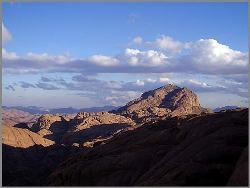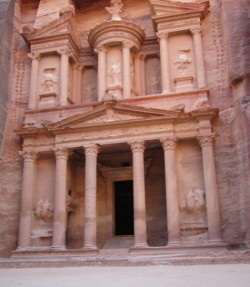
Photo. Jebel Musa is believed by many to be the Biblical Mount Sinai, where Moses received the Ten Commandments. © Information website for St. Katherine and the Sinai High Mountain Region in the Governorate of South Sinai, Egypt (www.St-Katherine.net).
The Jews received the Ten Commandments at the top of Mount Sinai, but where is this Biblical Mount Sinai?
The big mystery is still not solved. It has for a long time been discussed by researcers, scientific and religious people where the Ten Commandments written on stone tablet were given to Moses by God. There has been conducted widely search for finding the mountain where it took place. Not even the Stone Tablets have been found. They go under the names: The Tablets of Stone, Stone Tablets, Tablets of Law, or Tablets of Testimony in the Bible. They were the two pieces of special stone inscribed with the Ten Commandments when Moses stood on the top of Mount Sinai as recorded in the Book of Exodus. Exodus 31:18 refers to the tablets as the "Tablets of Testimony" because they give insight into the nature of God.
The name of Mount Sinai is strongly connected to the story of Moses and the Ten Commandments. Exodus 19:16-20 says: “The Lord came down on the top of Mount Sinai and called Moses to the top of the mountain.”
As stated on the information website for St. Katherine and the Sinai High Mountain Region in the Governorate of South Sinai, Egypt (www.St-Katherine.net), Mount Sinai is the Biblical Mount Horeb, known locally as Jebel Musa, where Moses received the Ten Commandments. At the foot of Mount Sinai is the magnificent St. Catherine’s Monastery, a UNESCO World Heritage Site, run by Eastern Orthodox monks and one of the oldest Christian monasteries in the world. St. Katherine's Monastery is the oldest continuously inhabited monastery in the World built on the site where Moses (Prophet Musa) spoke to God in the miracle of the Burning Bush, and to climb Mount Sinai, the Biblical Mt. Horeb, known locally as Jebel Musa, where Moses received the Ten Commandments. The town of St. Katherine is in the Sinai peninsula in Egypt at an elevation of about 1600 meters from sea level. For more information: www.St-Katherine.net
Another theory is that the site at Mount Karkom is the Biblical Mount Sinai. Professor Emmanuel Anati, who was in charge of the Har Karkom Archaeological Survey, believe he has the answer. His compelling hypothesis derived from his work, carried out over many years, that looked for evidence linking Biblical Sinai with the site at Mount Karkom. Mount Karkom, in Israel’s bleak Negev Desert, is about half way between the ancient city of Kadesh Barnea and the Nabatean city of Petra.
It`s also a theory indicating that the Jebel al-Madhbah, meaning mountain of the Altar, at Petra, is being identical to the biblical Mount Sinai. Based on a number of local names and features, in 1927 Ditlef Nielsen identified the Jebel al-Madhbah (meaning mountain of the Altar) at Petra as the biblical Mount Sinai. Since then, as well as a number of scholars, a number of amateur investigators such as Graham Phillips, Andrew Collins, and Chris Ogilvie-Herald have also made the identification (Source: Wikipedia).
|
Photo. The Siq, facing the Treasury, at the foot of Jebel al-Madhbah. © Travel Explorations.
The valley in which Petra resides is known as the Wadi Musa, meaning valley of Moses, and at the entrance to the Siq is the Ain Musa, meaning spring of Moses; in the 13th century an Arab chronicler Numari stated that Ain Musa was the location where Moses had brought water from the ground, by striking it with his rod.
|
 |
The Jebel al-Madhbah was evidently considered particularly sacred, as the well known ritual building known as The Treasury is carved into its base, the mountain top is covered with a number of different altars, and over 8 metres of the original peak were carved away to leave a flat surface with two 8 metre tall obelisks sticking out of it. These obelisks, which frame the end of the path leading up to them, and are now only 6 metres tall, have led to the mountain being colloquially known as Zibb 'Atuf, meaning penis of love in Arabic.
Archaeological artifacts discovered at the top of the mountain indicate that it was once covered by polished shiny blue slate, fitting with the biblical description of paved work of sapphire stone; biblical references to sapphire are considered by scholars to be unlikely to refer to the stone called sapphire in modern times, as sapphire had a different meaning, and wasn't even mined, before the Roman era. Unfortunately, the removal of the original peak has destroyed most other archaeological remains from the late Bronze Age (the standard dating of the Exodus) that might previously have been present.
Would there some day be specific evidences that can prove where Moses received the Ten Commandments from God?
Stein Morten Lund, 21 August 2009
Additional information
Another Biblican site related to Moses is Mount Nebo, Jordan, which is today a place of pilgrimage for thousands of people. According to the Bible, it was there Moses saw the Promised Land. The Bible, Deuteronomy 34:1-7, tells the story of Moses’s journey to Mount Nebo. It says: “Moses went up from the plains of Moab to Mount Nebo, to the top of Mount Pisgah east of Jericho and there the Lord showed him the whole land: the territory of Gilead as far north as the town of Dan. Read more about Biblical places on our global travelguide Travel Explorations: www.TravelExplorations.com













